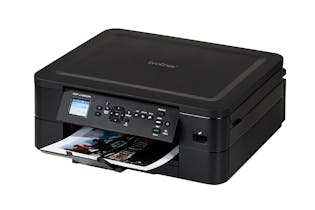Printers
Find the best printer for your home with our buying guide and test results for 63 current and 43 discontinued models.
We’ve tested inkjets and lasers to see which are best at printing, scanning, copying, and energy economy.
Types of printer
Inkjets are the all-rounders of the printing world. They’re often smaller and can print photos. They’re also cheaper to buy on average, especially if you want scanning and copying. However, you need high-quality paper to get the best out of an inkjet. They work by using tiny heaters or vibrating crystals to propel droplets of ink on to the paper.
Lasers print faster than inkjets on average. They also produce sharper black and white text, even on cheap paper, so they’re perfect if you do heaps of mono printing. However, they usually don’t print colour, and scanning and copying functions are rare too. They work by ionising the paper and fixing powdered toner to it.
All-in-one and multifunction printers
Printers that can also scan are marketed as multifunction or all-in-one printers. They're the norm these days, but if you won't find scanning useful, you might be able to save a few dollars with a more basic printer.
- Scanning: A built-in flatbed scanner allows you to capture photos and documents and save them to your computer. Most models come with optical character recognition (OCR) software, which allows text to be scanned in and saved as a word processor file. With all flatbed scanners, depth of field can be a problem. Most models only scan clearly when the item’s pressed hard up against the glass plate – tricky when copying a book.
- Copying: The combination of a scanner and printer allows a multifunction to act as a copier too. However, you may find the speed frustrating if you’re used to a standard photocopier – and the cost per page is much higher.
- Faxing: Some multifunction printers have a faxing function, but it’s no longer common.
Other features to consider
- Colour or mono: All inkjet printers can print colour, while less than half of lasers can.
- Resolution: This is measured in dots per inch (dpi). Quality can be limited by low resolution, but high resolution doesn’t guarantee good results.
- Tray size: Most home printers hold 150 to 250 A4 sheets. If you want to print in larger quantities or a different paper size, make sure the printer has a suitable tray.
- Auto-duplexing: Automated double-sided printing, where a printed page is fed back into the printer.
Printer connections
Think about which computer, tablet or phone you’ll be printing from, and how you’ll connect to it. On smaller devices, you’ll likely need to download an app. The most common connections are:
- WiFi – connects your printer to a home WiFi network, letting you wirelessly print from any device on that network.
- WiFi Direct / Bluetooth – one-on-one wireless connections, similar to WiFi but with no router involved.
- Ethernet port – connects the printer directly to a router or PC via ethernet cable.
- USB port – allows printing from a flash drive.
- Near-field communication (NFC) – lets you print by “tapping” your phone or tablet on to the printer, using similar tech to contactless payment.
- Memory cards – some printers have slots that accept various memory cards used in digital cameras. Examples are SD (Secure Digital), MS (Memory Stick) or CF (Compact Flash).
The driver is the software that tells the printer how to interact with other software, such as your word processor or picture viewer. Many printers don’t come with up-to-date drivers, but the latest version can often be downloaded online.
Tips to cut costs
- Regularly using your inkjet printer every few weeks keeps the printheads from clogging, which reduces maintenance costs.
- Even if you’ve drafted your document in black and white, your printer might still use colour ink. Make sure to select black and white in your print settings when printing plain text pages.
- Getting your cartridges refilled is cheaper and less harmful to the environment than buying new ones.
- Consider using third-party cartridges. We suggest buying from a company that guarantees compatibility with your printer so that, if they don’t work, you have protection under the Consumer Guarantees Act. There are websites that help you compare third-party cartridges, including compatibilities.
- You can buy larger cartridges, often called X, XL or high yield. They’re the same dimensions as standard cartridges but loaded with more ink. They cost less per gram, but are still less economical than an ink tank.
- Printing double-sided (duplex) can halve your paper costs.
The long-term cost of ink
Ink is a major ongoing cost for printers. In fact, over the life of a printer, it’s not unusual to spend more on replacement ink than you spent on the machine itself.
Because inkjets use liquid ink, a lot tends to be wasted when it dries on the printhead. Lasers use dry ink, so they don’t have this problem. For more about ink usage and common problems with ink cartridges, read our article about printer ink.
Ink tank printers have lower ink costs
Some inkjet printers don’t use replaceable cartridges at all, instead storing ink in high-capacity tanks. Tanks can print a lot more pages and are easier to refill. They’re also less wasteful, which is better for the environment. However, the printers cost more upfront because the business model is different – the manufacturer needs to make most of its profit from the machine itself rather than from replacement cartridges.
Each printer manufacturer has a different name for their ink tank technology: Epson has EcoTank, HP uses Smart Tank and Canon has Pixma Endurance.
We've tested 106 printers.
Find the right one for you.
Brother

.jpg&w=315&q=75)
.jpg&w=315&q=75)